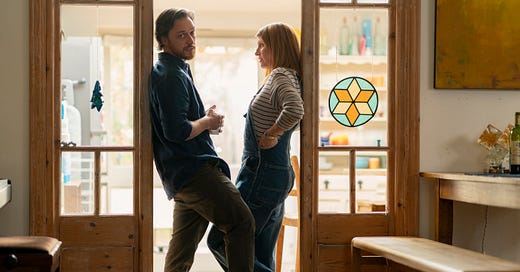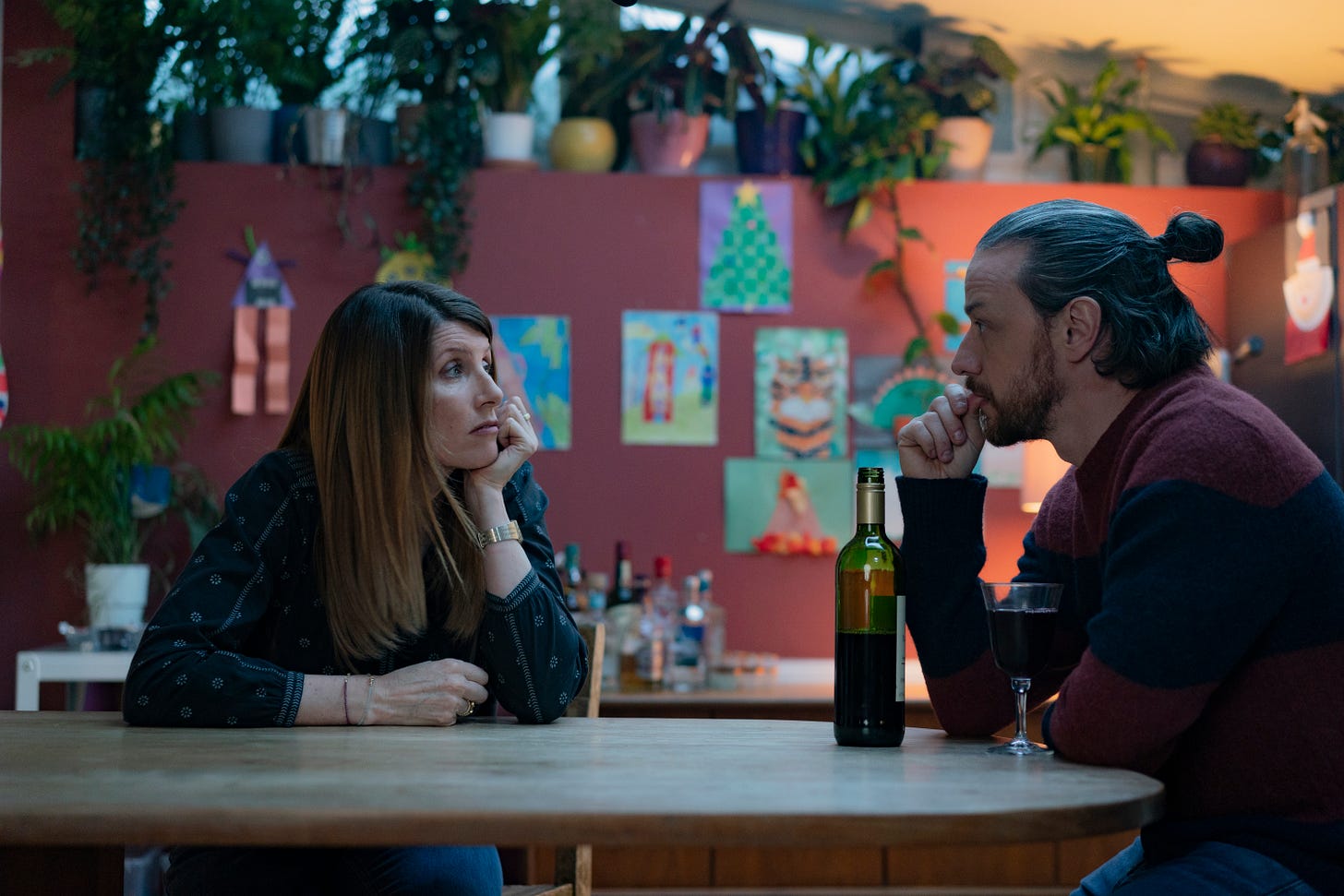Estranged Bedfellows
James McAvoy and Sharon Horgan play lovers in lockdown in "Together"
“Together” was released to theaters at the end of August for reasons that elude me – it’s not a movie so much as the first pandemic teleplay. As such, it’s quite good. Yes, it mostly consists of two people stuck in a house talking to each other when they’re not talking to the camera, but the two people are James McAvoy, an actor who is addictive to watch, and Sharon Horgan, half of Amazon’s delightful anti-romance “Catastrophe,” so rewards are there. As of September 14, it’s available for rent on Amazon and DirecTV.
The conceit is that He and She – never named – are an unmarried London couple heading into lockdown in a state of mutual loathing. Bad for them, good for us, because few actors give voice to splenetic revulsion as amusingly as these two. As scripted by Dennis Kelly and directed by Stephen Daldry (“Billy Elliot”), the opening scenes are an essay in the art of contumely:
He: “I hate your face.”
She: “Are you saying I’m unattractive?”
He: “Nooo, no, you’re very attractive. (to us) She’s very attractive. (to her) It’s just your face. I totally hate it.”
She: (to us) “I actually think of him as a cancer. Not skin or testicle, but one of the really bad ones.”
Does it matter that, like the actors playing them, He and She are respectively Scottish and Irish? Of course it does – the warring burrs and brogues give the insults an extra topspin, as does the fact that they’re playing to an invisible audience on the other side of the screen. They’re that couple you might know who detest each other entertainingly, embarrassingly, and at parties – whose battles can seem like a weird form of love. Except that these two appear to genuinely hate each other. All that’s holding them together is a young son (Samuel Logan) who ghosts through the background in a series of footie pajamas, serene and rather unbelievably above the fray.
Ty Burr’s Watch List is a reader-supported newsletter. Both free and paid subscriptions are available. Those who want to support my work are encouraged to take out a paid subscription.
“Together” opens in February 2020 with lockdown orders and toilet-paper hoarding, and it progresses through the year, ticking off the months, COVID-19 deaths, and ultimately the number of vaccinated. We know that She and He are going to fall back in love eventually, but the question is how, since they’re so impressively skilled with the needle and the shiv. He’s a by-the-bootstraps conservative and she’s a progressive softie — a combination that makes for DEFCON-1 levels of seething — but they do say nice things about each other in a spirit of temporary defeat, and there’s an early tragedy (don’t worry, it’s not the kid) that results in a truce and something that might be called tenderness. Over time, hair lengthens into man-buns; vegetable gardens take root and cooking skills improve. Sex reappears, to the shock of both parties.
The rowhouse where the couple lives is cluttered and charming, but still, we’re stuck with these two for the duration, so how does “Together” keep it together? Through the deftness of the performances and the athleticism of the dialogue, and through the regular salting of monologues that allow McAvoy and Horgan to express all the anxiety and sorrow and political fury we’ve felt this past year and a half. McAvoy’s scenes in particular are riveting, with one long speech that travels from pride in the asparagus he’s growing to the devastation of a loved one’s lonely death. Within that arc are microshifts in tone and feeling you never see happening – you’re as shocked as the character at where he ends up.
McAvoy often likes to go big, and he can be hilarious in schlock like “Victor Frankenstein” while breaking your heart in a National Theatre production of “Cyrano de Bergerac.” Here he’s working on an intimate scale but with a creative intensity that gives every gesture wit and weight, and Horgan is nearly his equal. “Together” is basically just a two-person play – two and a half if you count the son – but it feels as if it’s being staged in our living rooms, and it charts the humbling and reconnecting of one couple in ways that ripple out far past the screen.
If you enjoyed this edition of Ty Burr’s Watch List, please feel free to share it with friends.
Or subscribe. Thank you!





